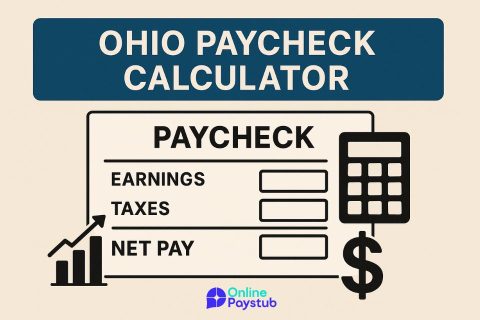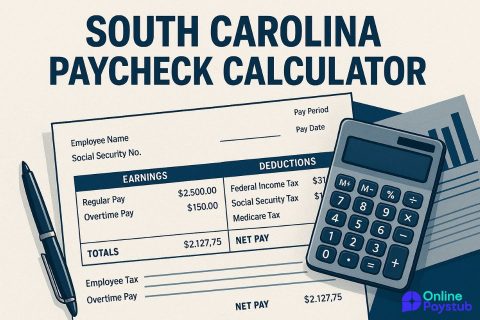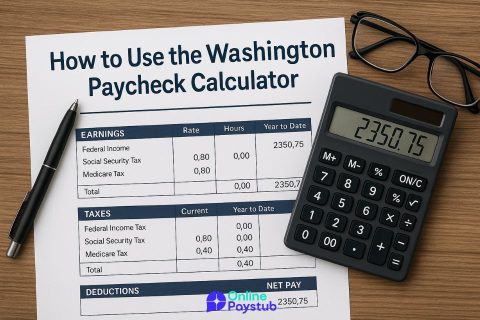For anyone employed in Massachusetts, understanding how a paycheck is calculated is more than just knowing the gross amount you’re paid. Your actual take-home pay the net amount after taxes and deductions can differ significantly based on factors like your federal and state tax withholdings, benefit contributions, and filing status.
Massachusetts has a flat personal income tax rate of 5% for earnings up to $1 million, increasing to 9% for income above that threshold. Additionally, employers are required to withhold federal taxes including Social Security and Medicare, as well as state-mandated programs such as Paid Family and Medical Leave (PFML). Each of these layers plays a role in calculating the final amount that lands in your bank account.
Understanding Gross vs. Net Pay in Massachusetts
Before you can evaluate your paycheck, it’s important to distinguish between two critical terms: gross pay and net pay. These values appear on every pay stub, yet they represent fundamentally different aspects of your compensation.
Gross pay refers to your total earnings before any taxes or deductions are applied. This includes your base salary or hourly wages, overtime, bonuses, commissions, and any other compensation earned within the pay period. For salaried employees, this is typically expressed as an annual figure, while for hourly workers, it results from multiplying hours worked by the pay rate.
Net pay, on the other hand, is what you actually receive in your bank account. It’s your gross pay minus a series of deductions, including:
- Federal income tax
- FICA taxes (Social Security and Medicare)
- Massachusetts state income tax
- Paid Family and Medical Leave (PFML) contributions
- Employer Medical Assistance Contribution (EMAC), when applicable
- Any pre-tax benefit contributions (e.g., 401(k), HSA, FSA)
- Optional post-tax deductions like insurance premiums or union dues
To illustrate, if you’re a Massachusetts resident earning $60,000 per year, your gross monthly pay would be $5,000. After deductions, your actual take-home pay might range from $3,600 to $4,100 depending on your filing status and benefit elections.
What Taxes Are Withheld from Massachusetts Paychecks?
Every Massachusetts paycheck includes a set of mandatory tax withholdings that reduce your gross income before you receive your earnings. These taxes support both federal and state programs and vary slightly based on your income level, benefits, and employment structure.
Federal Income Tax
This is determined using the IRS Form W-4, which includes your filing status, number of dependents, and any additional withholding you specify. The federal withholding is progressive, meaning higher income brackets face higher tax rates.
FICA Taxes
The Federal Insurance Contributions Act (FICA) mandates two separate taxes:
- Social Security: 6.2% of wages up to the annual limit ($168,600 in 2024)
- Medicare: 1.45% of all wages, plus an additional 0.9% on income above $200,000 for single filers
Both of these taxes are matched by the employer.
Massachusetts State Income Tax
Massachusetts levies a 5% flat income tax on most earned income. However, if your income exceeds $1 million annually, a 4% surtax (resulting in a 9% total) applies to the amount above that threshold.
Paid Family and Medical Leave (PFML)
Massachusetts requires contributions to its PFML program from both employees and employers. The rates and contribution limits are adjusted annually by the state. Both medical and family leave deductions appear as separate line items on your pay stub.
Employer Medical Assistance Contribution (EMAC)
EMAC is an employer-side tax but may indirectly influence payroll decisions and total compensation. While it doesn’t appear as a deduction from your paycheck, it’s an important piece of the overall tax structure.
Federal Withholding Explained: W-4 and Your Paycheck
Federal withholding plays a critical role in shaping your net income, and the IRS Form W-4 determines how much is taken from your paycheck to cover your annual federal tax liability. It’s essential to understand how this form functions especially after the IRS redesign in 2020.
How W-4 Affects Your Paycheck
The W-4 no longer asks for allowances. Instead, it includes sections where you:
- Indicate filing status (e.g., single, married filing jointly, head of household)
- List dependents, which directly lowers your taxable income
- Add other income not subject to withholding (e.g., dividends, freelance earnings)
- Specify any extra withholding you want applied per paycheck
These inputs guide your employer in calculating federal tax withholding. The more dependents or deductions you claim, the less federal tax is withheld. Conversely, if you report additional income or request extra withholding, more will be taken out.
Multiple Jobs or Spouse Employment
If you have more than one job or a spouse who also works, the IRS recommends accounting for that on your W-4 using the dedicated worksheet. Failing to do so could result in under-withholding, leading to an unexpected tax bill at year-end.
How Often Should You Update It?
You should review and potentially revise your W-4 if you:
- Start or leave a second job
- Experience a change in marital status
- Have a child or new dependent
- Expect significant changes in income or deductions
Optimizing your W-4 ensures that your paycheck accurately reflects your tax situation. However, state withholding is calculated separately. Next, we’ll explore how Massachusetts’s M-4 form works and how it affects your state tax withholding.




No comments to show.